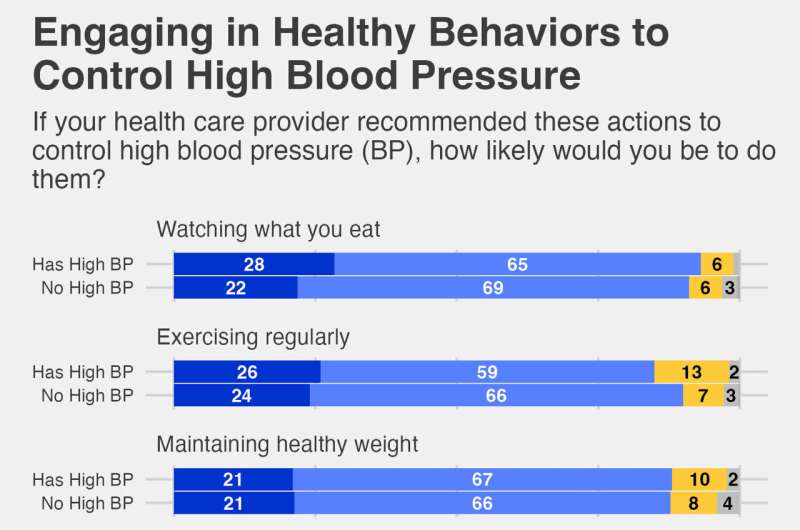Hypertension or high blood pressure, which can lead to heart attack and stroke, the two top causes of death in the United States, is one of the most widespread chronic illnesses in America, afflicting nearly half of adults. In a recent Annenberg Public Policy Center (APPC) health survey, 35% of respondents report having been diagnosed with high blood pressure and two‐thirds of this group say they’re somewhat or very worried about having high blood pressure.
But the survey finds that few U.S. adults—including those who have been diagnosed with high blood pressure—can correctly identify what blood pressure reading doctors consider “high.” A reading of 130/80 mm Hg or over is considered high, according to the U.S. Centers for Disease Control and Prevention (CDC), and just over 1 in 8 Americans know this.
The survey, conducted among 1,653 empaneled U.S. adults from April 15–28, 2025, finds that over a third think incorrectly that high blood pressure nearly always has noticeable symptoms like dizziness and shortness of breath (it doesn’t). And nearly 4 in 10 say incorrectly that feeling calm and relaxed is a sign that your blood pressure is in a normal range (it isn’t).
Despite these common misconceptions, the survey finds that a large majority of U.S. adults is familiar with measures that can help to lower high blood pressure—and they’re known both to people with high blood pressure and those who have not been diagnosed with it. (See the topline for the data.)
“Because controlling blood pressure reduces one’s risk of serious health problems, including heart attacks and strokes,” said Patrick E. Jamieson, director of the policy center’s Annenberg Health and Risk Communication Institute, “correcting misperceptions about ways to identify it should be a public health priority.”
Highlights
The Annenberg Public Policy Center’s April 2025 health survey finds that:
- Among the U.S. adults in our study who report ever being diagnosed with hypertension or high blood pressure, about two‐thirds are somewhat or very worried about it.
- Just 13% of Americans can identify the blood pressure reading that signifies high blood pressure—130/80 mm Hg or over—but more incorrectly think it is 140/90, an earlier cutoff point that was lowered by cardiologists in 2017. Nearly a quarter of Americans don’t know which reading indicates high blood pressure.
- Over a third of Americans think that high blood pressure nearly always has noticeable symptoms like dizziness and shortness of breath and nearly 4 in 10 say that feeling calm and relaxed is a sign your blood pressure is in a normal range. Neither claim is true.
- Most people are familiar with ways to lower blood pressure and say they would take these steps if a doctor recommended them—but fewer say they actually take these steps.
Most do not know how to define high blood pressure
Blood pressure is a measure of the pressure in the arteries when the heart beats. Blood pressure is stated as a pair of numbers—the upper number, or systolic pressure, shows the pressure when the heart beats (as measured in millimeters of mercury, mm Hg) and the lower number, or diastolic pressure, represents the resting pressure in between heartbeats, the American Heart Association (AHA) says. In 2017, the AHA and the American College of Cardiology redefined high blood pressure as 130/80 mm Hg, lowering it from the prior cutoff of 140/90.
High blood pressure, according to the CDC, was a primary or contributing cause of over 685,000 deaths in the United States in 2022.
In the survey, 35% of respondents report having been diagnosed with high blood pressure and 69% of respondents report having a family member other than themselves with this condition.
Despite the prevalence of this chronic condition, few people can define what constitutes high blood pressure. Respondents were provided with five possible sets of numbers and asked which represents the onset of high blood pressure. Nearly 1 in 4 (24%) respondents say they are not sure at what point a blood pressure reading is considered high. People who report having high blood pressure are more confident about their knowledge of the cutoff (just 10% are not sure), compared with those without the diagnosis (32% not sure).
A quarter of respondents (25%) chose the old, pre-2017 cutoff of 140/90 and over; 16% chose over 140/80; 18% chose over 130/90; and 13% opted for the correct, current definition of over 130/80.
What people get wrong and right about high blood pressure
The survey finds that a significant number of people get two consequential claims about high blood pressure wrong and one right:
- Many don’t know it’s typically a “silent” illness: Over a third of people (37%) incorrectly say that someone with high blood pressure nearly always has noticeable symptoms like dizziness or shortness of breath. The CDC says high blood pressure “typically has no signs or symptoms,” as 39% of survey respondents know, including half of those with high blood pressure (50%) but fewer of those (33%) without the diagnosis. The American Heart Association says that the usual absence of symptoms is why high blood pressure is known as “the silent killer.”
- Feeling calm and relaxed is not a sign: Nearly 4 in 10 people (39%) incorrectly say “feeling calm and relaxed” is an indication that your blood pressure is in the normal range. This is false, as 53% of those with high blood pressure but just 40% of those without high blood pressure know. Seventeen percent are not sure if this is true.
- If it runs in the family: Most people (80%) accurately know that if high blood pressure runs in your family, it’s false to say there’s nothing you can do to effectively reduce it.

Most know steps to lower high blood pressure
In general, Americans know which activities can and cannot help to lower your blood pressure. Asked which of the following would lower blood pressure, the vast majority of respondents selected the correct answers and very few selected the incorrect ones:
- Maintaining a healthy weight (91%)
- Regularly exercising (89%)
- Watching what you eat to maintain a healthy nutritious diet (89%)
- Taking medication (84%)
- Reducing salt intake (82%)
- Drinking coffee (false) (3%)
- Regularly drinking alcohol (false) (2%)
“The high level of public knowledge about the habits that reduce blood pressure is heartening and a tribute to the health care providers and public health agencies that have centered this health indicator in the national consciousness,” said APPC research analyst Laura A. Gibson.
How likely do people say they are to engage in healthy behaviors?
The vast majority of those surveyed say that if their doctor or health care provider recommended the following actions to control high blood pressure, they are “somewhat likely” or “very likely” to do them or “already do them regularly”:
- Watching what they eat to maintain healthy nutrition (92%)
- Limiting salt intake (88%)
- Exercising regularly (88%)
- Getting to and maintaining a healthy weight (88%)
- Monitoring their blood pressure readings (87%)
- Taking blood pressure medication (79%)
Medication. Significantly more people who report having been diagnosed with high blood pressure (93%) say they take or would be likely to take blood pressure medication if recommended by a doctor, compared with 72% who do not have high blood pressure. This matches what people who have high blood pressure report actually doing: Among those whose doctors say they need it, 90% say they take medication daily. The most common reason the other 10% say they do not take it daily is that they don’t think doing so is necessary.
Monitoring blood pressure. Comparing people with high blood pressure with those who do not have it, there is no difference in whether they say they would be likely to monitor their blood pressure if it is recommended by a doctor—87% of both groups said they would do so. Among those with high blood pressure, 10% say they monitor it daily or nearly so, 19% once or several times a week, and 27% once or a few times a month. The AHA advises blood pressure monitoring at home at the same time each day and talking “with your health care professional about how often to take your blood pressure.”
Diet and exercise. There is no significant difference between those with and without high blood pressure in the percentage of those who would exercise regularly (or currently do) to control high blood pressure at a doctor’s recommendation—85% with high blood pressure say they would and 90% of those without the diagnosis say they would. Nor is there a significant difference among those who say they would be likely to (or do) watch what they eat to maintain healthy nutrition (93% with high blood pressure vs. 91% without). And the percentage who say they would be likely to get to and maintain a healthy weight is also the same, 88% for both groups.
Healthy behaviors people say they would do and what they currently do
Although 88–92% of those in the general population say they are likely to exercise regularly and watch what they eat to support their health, only 57–72% report actually engaging in these behaviors more than once a week.
The following proportions say they engage in each of the following healthy behaviors more than once a week:
- Watching what they eat to support their health (72%)
- Exercising regularly (61%)
- Limiting salt intake (57%)
Watching what you eat. The frequency with which U.S. adults say they watch what they eat is statistically the same for both groups (73% of those with a high blood pressure diagnosis report watching what they eat more than once a week vs. 70% of those who report no diagnosis).
Engaging in physical activity. The frequency with which people report engaging in physical activity or exercise is statistically the same among people who do and do not report having a diagnosis of high blood pressure.
Salt intake. The frequency with which people say they limit their salt intake differs by high blood pressure diagnosis (69% of those with a diagnosis limit salt more than once a week vs. 51% of those who report not having been diagnosed).
APPC’s Annenberg science and public health knowledge survey
The survey data come from the 24th wave of a nationally representative panel of 1,653 U.S. adults conducted for the Annenberg Public Policy Center by SSRS, an independent market research company. Most have been empaneled since April 2021. To account for attrition, replenishment samples have been added over time using a random probability sampling design. The most recent replenishment, in September 2024, added 360 respondents to the sample.
This wave of the Annenberg Science and Public Health (ASAPH) survey was fielded April 15–28, 2025. The margin of sampling error (MOE) is ± 3.4 percentage points at the 95% confidence level. All figures are rounded to the nearest whole number and may not add to 100%. Combined subcategories may not add to totals in the topline and text due to rounding.
The policy center has been tracking the American public’s knowledge, beliefs, and behaviors regarding vaccination, COVID-19, flu, RSV, and other consequential health issues through this survey panel for four years. In addition to Gibson and Jamieson, APPC’s team on the survey includes research analyst Shawn Patterson Jr., Ken Winneg, managing director of survey research, and APPC director Kathleen Hall Jamieson.
More information:
Download the topline and the methods report.
Annenberg Public Policy Center of the University of Pennsylvania
Citation:
Many Americans unaware high blood pressure usually has no noticeable symptoms (2025, June 6)
retrieved 6 June 2025
from https://medicalxpress.com/news/2025-06-americans-unaware-high-blood-pressure.html
This document is subject to copyright. Apart from any fair dealing for the purpose of private study or research, no
part may be reproduced without the written permission. The content is provided for information purposes only.

